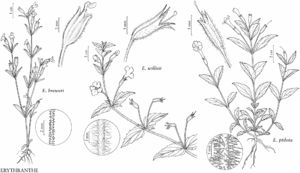Erythranthe ptilota
Phytoneuron 2017-17: 4. 2017.
Perennials, rhizomatous, sometimes rooting at proximal nodes. Stems prostrate, sometimes decumbent to ascending, few-branched, 20–80 cm, villous, hairs 1–2 mm, eglandular, sometimes mixed with much shorter stipitate-glandular ones, internodes evident. Leaves cauline, basal not persistent, often congested; petiole 0 mm, rarely 1–2(–3) mm; blade pinnately veined, oblong-lanceolate, 30–70 × 10–22 mm, base rounded, margins denticulate to dentate, apex acute, surfaces villous, hairs 1–2 mm, eglandular, sometimes mixed with much shorter stipitate-glandular ones. Flowers herkogamous, 4–10, from medial to distal nodes. Fruiting pedicels (15–)22–50 mm, villous, hairs 1–2 mm, eglandular, sometimes mixed with much shorter stipitate-glandular ones. Fruiting calyces wing- or plicate-angled, cylindric-campanulate, weakly inflated, 10–12 mm, villous-glandular, hairs gland-tipped, lobes distinctly spreading, strongly unequal, linear-lanceolate to narrowly triangular, 5–9 mm, apex long acuminate-apiculate. Corollas yellow, throat with fine blackish or brownish lines on all sides, weakly bilaterally or nearly radially symmetric, weakly bilabiate or nearly regular; tube-throat narrowly campanulate, 15–18 mm, exserted beyond calyx margin; lobe apex rounded. Styles glabrous. Anthers included, finely hirtellous to hispidulous. Capsules included, 6–8 mm.
Phenology: Flowering (May–)Jun–Aug.
Habitat: Creek banks, gravel bars, flood plains, shallow ditches and natural drainages, swales, damp banks, wet sand, moist soils in coniferous woods, marshes, bogs.
Elevation: 0–1000(–1900) m.
Distribution
B.C., Calif., Oreg., Wash.
Discussion
Erythranthe ptilota is recognized by its prostrate to decumbent or decumbent-ascending habit, large, consistently sessile leaves, densely villous vestiture, long pedicels, large calyces and corollas, hispid-hirtellous anthers, and particularly by its long, strongly unequal, linear-triangular calyx lobes usually distally falcate. Leaf bases typically are truncate to rounded or subcordate. Rarely the leaves are short-petiolate, but in such cases, the distinctive leaf bases, vestiture, calyx morphology, and pubescent anthers are diagnostic. Erythranthe ptilota is widely sympatric with E. moschata but usually occurs at lower elevations and characteristically in wetter habitats. The epithet ptilota (Greek ptilotos, winged) alludes to a fancied winglike aspect of the pairs of sessile leaves.
A population system of Erythranthe ptilota-like plants occurs in southern California, about 480 km disjunct from the main range of the species. These plants have the prostrate habit, large leaves, long pedicels, and large corollas of E. ptilota, but the calyx lobes are variable in length and usually do not show the characteristic attenuate-apiculate apices. The southern California plants are identified here as E. moschata.
Erythranthe ptilota is a new name at specific rank for Mimulus moschatus var. sessilifolius [not E. sessilifolia (Maximowicz) G. L. Nesom].
Selected References
None.
